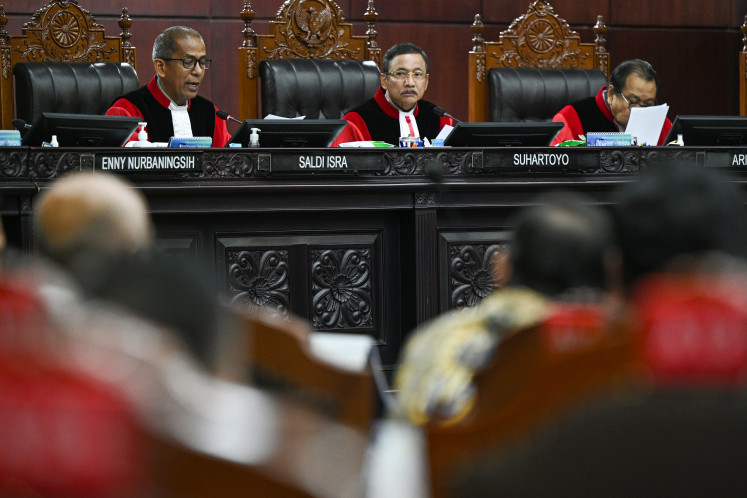Popular Reads
Top Results
Can't find what you're looking for?
View all search resultsPopular Reads
Top Results
Can't find what you're looking for?
View all search resultsUS pivot: The future of Indo-Pacific region (Part 1 of 2)
Truthfully, human civilization has lived for more than 4,000 years but has only experienced 800 years that were free of conflict
Change text size
Gift Premium Articles
to Anyone
T
ruthfully, human civilization has lived for more than 4,000 years but has only experienced 800 years that were free of conflict.
As in the wilderness, the survival of the fittest is indeed applicable to society. Relating to this survival theory the effectiveness of a military power becomes an important element in building state power. This is demonstrated by the history of the United States of America.
As a super power, US interventions in many of the world's strategic regional territories is linked more with the effort to confront potential geopolitical threats rather than its interest in energy resources and strategic sea lane routes for trade and military purposes.
Recently, the US repositioning campaign toward this region was held by conducting at least 175 combined military exercises, which involved 250 navy ships. It is only logical if countries within the region, such as China, continue to increase their defense budgets annually.
According to Andrew Forbes from The Sea Power Center Australia, it is estimated that by the year 2020, 56 percent of the world's population will be located in Asia, resulting in the region becoming the sixth most influential military power out of the top 10 most powerful military forces in the world.
It is also projected that Asia will rank as the third most powerful economy and will be the sixth biggest energy consumer.
This forecast is consistent with Henry Kissinger's prediction, which states that the Asia-Pacific region will be divided into a 'deadly triangle' that will compete due to economic growth, scarcity of resources and enrichment of military power between countries to address energy shortages, which will be crucial for the economic development of the region.
Increased US interest in the value of the Asia-Pacific region has been clearly identified in the 10 points of Cooperative Strategy of the 21st Century Seapower and the deployment of US military personnel in the area is currently in progress to achieve such strategic objectives.
At the Shangri-La Dialogue, best known as Repositioning Asia, Leon Panetta stated that 60 percent of the US military power will be relocated in the Asia-Pacific region and such strategy will involve an increased amount of military activities and will automatically involve at least 160,000 active duty personnel, 143 navy ships, 1,850 aircraft, six aircraft carriers, four amphibious transport docks, six landing ship docks, 11 cruisers, 31 destroyers, 13 frigates and 36 submarines.
Unmistakably, the return of US power demonstrates a geopolitical strategy that is experiencing a dramatic change, where regional influence now heavily relies on maritime power.
This strategy implemented by the US directly relates to the development of Chinese military power, as well as to claim authority over maritime disputes of the South and East China Sea.
Consequently this strategy will also support the achievement of Freedom of Navigation and Active Engagement Policy as well as expand US defense and security zones.
People's Liberation Army's (PLA) Maj. Gen. Luo Yuan stated that the development of the Chinese military in the Pacific and Indian oceans is to anticipate US military power: 'The so-called forward presence means that the US can send its gun boats to every corner of the world. This way, the US can even claim that the Yellow Sea and the South China Sea is covered within its security boundary.' This perspective drove China to successfully build its offshore defense in 2000-2010, which concentrated on the development of offshore combatant and brown water navy.
China plans to develop its first island chain and green water navy for 2010-2020 by focusing on surface navy ships, nuclear submarines and fighter aircraft.
Next, in 2020-2050 China will finalize its fighter jet program and enhance the enlargement of the blue water navy, which will give the country the capacity to operate in second island chains.
China's military power represents its national 'core interest', which incorporates littoral zone welfare, economic and treasured hegemonic values, closely linked to the security of sea lanes of
communications (SLOC) and chokepoints that have been the missing link in the issue of regional stability.
In the next seven to 37 years, the impact of Indonesia's attractive and strategic geopolitical state will cause the area to be prone to foreign threats, which will be more serious than the threats that were once posed by former colonial powers. Consequently, Indonesia's risks as a state, which acts as the regional maritime core, will experience increased simultaneous foreign military activities.
Regrettably, no Indonesian political or military elite has expressed a similar understanding. Factually, Indonesia is a truly sizeable archipelago, which longitudinally covers 13 percent of the world.
Indonesia has 12 oceans including overly strategic SLOC routes, which could position itself as Asia-Pacific's maritime core where through a geopolitical perspective the sea becomes crucial for the development of power, navy bases as well as the ability to acquire economic, defense and political interests.
The impact of Indonesia's attractive and strategic geopolitical state will cause the area to be prone to foreign threats.
The writer is executive director of the Institute of Defense and Security Studies, Jakarta.










